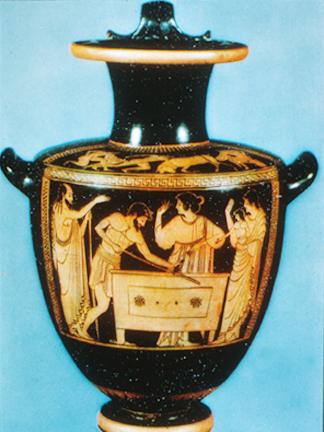
The Banishment of Perseus,
Greek Red Figure Hydria, 530-330 BCE
ART 198 - HISTORY OF WORLD CERAMICS
| This red figure vase shows a scene from the life of the Greek hero Perseus. The form is a hydria, another of the classic Greek vase shapes, featuring two side handles and another handle in the rear (not visible here in this photograph). The function of the hydria was to carry water, although it is doubtful that a piece painted with such artistry ever saw real function, but more likely was used decoratively or for ritual mixing of wine and water for religious ceremonies. In Greek mythology, Perseus would later slay the Gorgon Medusa and rescue Andromeda from a sea monster. He was the son of the god Zeus and the mortal Danae. Danae was the daughter of Acrisius of Argos, who had been told by an oracle that he would be killed by his grandson. So, when Danae gave birth to Perseus, Acrisius was understandably in fear of the child. So, he cast both Danae and Perseus adrift in the sea in a wooden chest. This scene depicts that chest being built by a carpenter. Acrisius is the figure at the far left bidding begone to his daughter Danae and her infant Perseus (at far right). The oracle was later proven right, when during the Olympic games, Perseus, now grown into a strong young man, would throw the discus in competition. Unfortunately, the discus would strike Acrisius in the head, killing him. | The Banishment of Perseus, Greek Red Figure Hydria, 530-330 BCE |
|
|